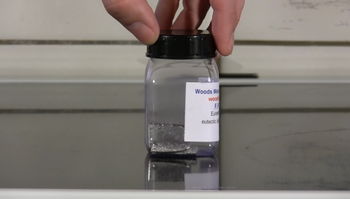Wood's metal
 |
This article is a stub. Please help Sciencemadness Wiki by expanding it, adding pictures, and improving existing text.
|
Wood's metal, also known as Lipowitz's alloy, is an eutectic, fusible alloy with a melting point of around 70 °C.
Commercial names for the alloy include Cerrobend, Bendalloy, Pewtalloy and MCP 158.
Contents
Composition
Wood's metal is an eutectic alloy consisting of 50% bismuth, 26.7% lead, 13.3% tin and 10% cadmium by weight.
Properties
Wood's metal is a dull gray soft metallic alloy, with a low melting point of 70 °C (158 °F), though the value of 73-77 °C also appears. Its latent heat of fusion is 40 kJ/kg, specific heat capacity 172 J/(kg·K). The average density for Wood's metal given in most sources is between 9.67-9.7 g/cm3, with the latter value being the most common.
Wood's metal has low reactivity with many acids, such as hydrochloric acid, but is rapidly corroded by nitric acid.
Availability
Wood's metal can be bought from lab suppliers and metal suppliers.
Fire-melted valve element in buildings fire sprinkler systems and medical gas cylinders in the United Kingdom have a Wood's metal seal which melts in fire, allowing the gas to escape and reducing the risk of gas explosion. However, due to the low amount of the alloy, this isn't a good source and it's advised to avoid tampering with gas cylinders for obvious reasons.
Some old toy train models used Wood's metal as counterweights.
Preparation
You can make Wood's metal by melting bismuth metal, then adding lead, tin and cadmium in their respective ratios. Keep the mixture molten and mix it using a stainless steel rod for at least one hour before pouring it in a mold and let it cool.
Safety
Working with molten metal poses a risk of serious burns, so it's best to wear proper protection like thick gloves.
Wood's metal contains lead and cadmium which are toxic. Avoid touching the metal in powdered form.
